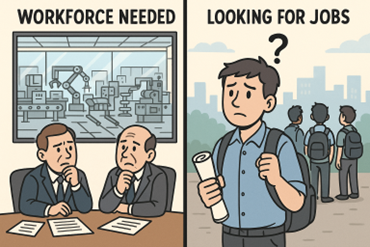



A well-timed scheme to empower India’s rural youth — all it needs is purpose, discipline, and delivery.
By Ravishankar Kalyanasundaram
The Prime Minister’s PM-SETU — the Scheme for Economic Transformation through Upgraded Skills — is one of the most promising national initiatives in recent years. A ₹60,000 crore plan to modernise 1,000 Government ITIs through a hub-and-spoke model, connect rural youth with industry, and prepare India’s workforce for a changing global economy.
It is a timely and visionary step. The world is short of workers.
Across East Asia and Europe, factories, hospitals, and logistics hubs are struggling to find hands. Japan, Korea, and even China are ageing fast. Meanwhile, India’s towns and villages are full of young diploma-holders wondering how to cross the bridge from learning to livelihood. PM-SETU can be that bridge — if built with precision and accountability.
Intent Alone Is Not Enough
This is not a complaint — it is a concern born of experience. India has never lacked ambition; it has often lacked architecture.
Schemes begin with great purpose and fanfare, but lose direction in execution.
The Smart Cities Mission, meant to redefine urban living, ended up as a patchwork of projects — with weak oversight, missing audits, and, in many cases, funds diverted to routine works. The Skill India Mission trained millions, but only a fraction found jobs. Training centres mushroomed, but employer verification was thin, and tracking outcomes nearly impossible.
Each of these began with good intent. Yet the absence of a clear blueprint, measurable targets, and a system for course correction turned enthusiasm into disappointment.
The fear is not that PM-SETU will fail — the fear is that it may stray from its intention and quietly join the long list of well-meaning programmes that lost their way.
Blueprint Before Budget
A scheme of this magnitude needs a plan, not a presentation.
Before the first rupee is spent, three pillars must be firmly in place:
Define who owns delivery — a Ministry, a dedicated agency, or a professional PM-SETU Mission Unit. Clarity of ownership is the first step to accountability.
Success must be measured not by the number of trainees, but by how many find and retain jobs. Placement within 90 days and retention at six months are the only numbers that matter.
India’s reviews are too often post-mortems. PM-SETU must be monitored in real time — a public dashboard showing enrolment, completion, employment, and employer feedback.
With these fundamentals, PM-SETU can set a new governance benchmark — not just for skills, but for how national programmes are managed.
A World That Needs India’s Workers
The scheme comes at a defining moment.
The world’s demographic pyramid is turning upside down. Nations like Japan and Germany need workers in manufacturing, healthcare, and infrastructure. Even the Gulf and Southeast Asia face shortages. India, by contrast, has the world’s largest youth cohort — a surplus of energy waiting for direction.
This contrast is both a challenge and a gift. It gives India a once-in-a-century opportunity to position itself as the workforce capital of the world — if our youth are trained with global precision, not just local aspiration.
Countries like Singapore, Hong Kong, and China did not reach industrial maturity through college degrees alone. They built their strength on skill systems — with clear job pathways, trained instructors, and constant industry dialogue. India must do the same.
Borrow Method, Not Glamour
When we speak of learning from abroad, we often confuse glamour with method.
What India needs is not consultants with slide decks, but partners with proven systems.
Singapore’s ITE Education Services (ITEES) and Workforce Singapore (WSG) offer exactly that — institutions that have built a culture where skill training equals employability. Their model rests on three principles:
This is the kind of partnership India needs — not as a foreign endorsement, but as a disciplined framework that holds everyone accountable.
A Practical Agenda for Action
To translate PM-SETU from vision to vocation, a few simple steps can make a powerful difference:
These are not big reforms; they are management basics that can make or break the mission.
From Vision to Vocation
The Prime Minister has given India a bold and timely vision.
Now the Government must match it with method — clear goals, disciplined delivery, and transparent review.
Handled with purpose, PM-SETU can turn India’s youth surplus into the world’s workforce dividend. Handled casually, it risks becoming another headline without history.
The difference between success and drift will not lie in money or speeches — but in method, metrics, and management.
That, ultimately, is the bridge India must build right.